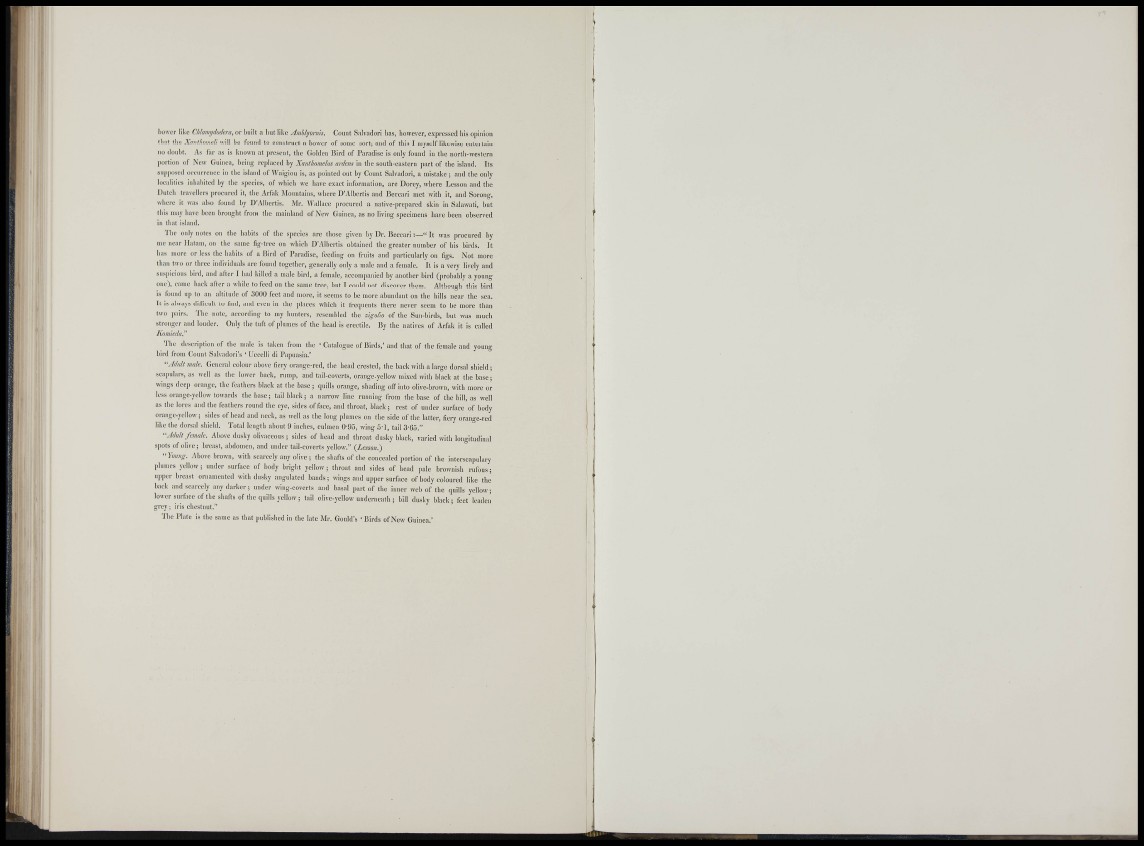
l l o w CI- lilie Chlmmjdodcrii, or binit a Imt like yImUijoriiis. Count Snlvaclori lias, liowever, expressed his ojiinioii
that Ihe Xmithomdi will he fonrid to construct a bower of some sort, and of this I myself likewise entertain
no doubt. As far as is known at present, the Golden Bird of Paradise is only found in the north-western
]iortioM of New Guinea, heiui,^ re|)laced by Xanthomelus aricm in the south-eastern j)art of tiie island. Its
su|i|iosed occurrence in the island of Waigiou is, as jiointed out by Count Salvador!, a mistake; and the only
localities iriliahited by the species, of which we have exact information, are Dorey, where Lesson and the
Dutch travellers procured it, tlie Arfak Mountains, wliere D'Albertis and Beccar! met with it, and Sorong,
where it was also found by D'Albertis. Mr. iVaUace procured a native-prepared skin in Salawat!, bnt
this may have been brought from the mainland of New Guinea, as no living specimens have been observed
in that isliinil.
The only notes on the habits of tlie species are tliose given by Dr. Beceari :—" It was procured by
me near Ilatam, on the same fig-tree on which D'Albertis obtained the greater number of his birds. It
has more or less the habits of a Bird of Paradise, feeding on fruits and particularly on figs. Not more
than two or three individuals are fouiid together, generally only a male and a female. It is a very lively aud
suspicious bird, and after I had killed a male bird, a female, accompanied by anotlier bird (probably a young
one), came back after a while to feed on the same tree, but I could not discover them. Although this bird
Is fouiid up to an altitude of .'iOOO feet and more, it seems to be more abundant on the hills near tlie sea.
It is always dlHicult to fimi, and even in the places which It frequents there never seem to be more than
two pairs. The note, according to my hunters, resembled the cigolìo of the Sun-birds, but was much
stronger and louder. Only the tuft of plumes of the head is erectile. By the natives of Arfak It is called
Komicdii."
The descrl]itlon of the male Is taken from the ' Catalogue of Birds,' and that of the female and
young
bird I'rom Count Salvadori's ' Uccelli di Papuasia.'
"Jdnlt male. General colour above fiery orange-red, tlie bead crested, the back witli a large dorsal shield ;
scapulars, as well as the lower back, rump, and tail-coverts, orange-yellow mixed with black at the base;
wings deep orange, the feathers black at the base; quills orange, shading off into olive-brown, with more or
less orange-yellow towards the base; tall black; a narrow line running from the base of the bill, ;is well
as the lores and the feathers round the eye, sides of face, and throat, black; rest of under surface'of body
orange-yellow; sides of liead and neck, as well as the long plumes on the side of the latter, fiery orange-red
like the dorsal shield. Total length about 0 inches, culmen 0-95, ivlng S ' l , tail 3-Co."
"Adult fi,nak. Above dusky olivaceous; sides of bead and throat dusky blaek, varied with longitudinal
spots of olive; breast, abdomen, and under tail-coverts yellow." {Lesson.')
"Young. Above brown, with scarcely any olive ; the shafts of the concealed j,ortlon of the interscapulary
phinies yellow ; under surfaec of body briglit yellow ; throat aud sides of head pale brownish rufous ;
upper breast ornamented with dusky angulated bands; wings and upper surface of body coloured like the
back and scarcely any darker ; under wing-eoverts and basal part of the inner web of the quills yellow;
lower surfi.ce of the shafts of the quills yellow ; tall olive-yellow underneath ; bill dusky black ; feet leaden
grey ; iris chestuut."
The Plate Is the same as that publislied in the late Mr. Gould's ' Birds of New Guinea.'